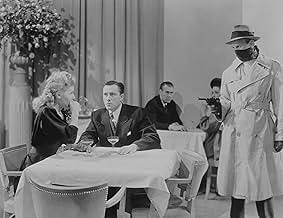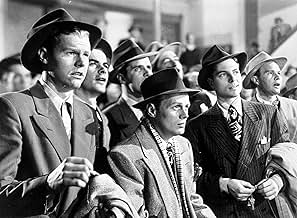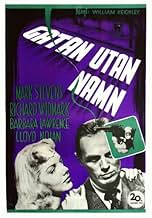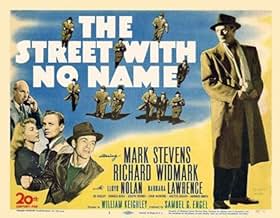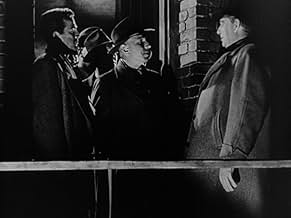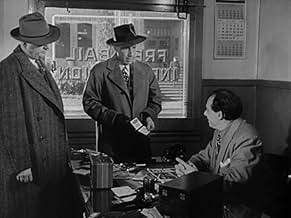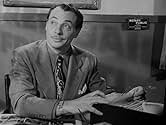CALIFICACIÓN DE IMDb
7.0/10
3.5 k
TU CALIFICACIÓN
Agrega una trama en tu idiomaA covert FBI agent infiltrates a ruthless gangster mob, but his life is at risk from a mysterious informant who funnels inside information to the hoodlums.A covert FBI agent infiltrates a ruthless gangster mob, but his life is at risk from a mysterious informant who funnels inside information to the hoodlums.A covert FBI agent infiltrates a ruthless gangster mob, but his life is at risk from a mysterious informant who funnels inside information to the hoodlums.
- Dirección
- Guionistas
- Elenco
- Premios
- 2 premios ganados y 2 nominaciones en total
Larry Anzalone
- Sparring Partner
- (sin créditos)
George Barrows
- Bouncer at Gym
- (sin créditos)
Joan Blair
- Valentine Laval
- (sin créditos)
James J. Casino
- Cornerman
- (sin créditos)
Lane Chandler
- Policeman at Arcade
- (sin créditos)
Dick Cherney
- Man at Gym
- (sin créditos)
Noble 'Kid' Chissell
- Prisoner
- (sin créditos)
Edmund Cobb
- Desk Sergeant
- (sin créditos)
- Dirección
- Guionistas
- Todo el elenco y el equipo
- Producción, taquilla y más en IMDbPro
Opiniones destacadas
At first, the docu-drama approach feels like kind of a safety net that prevents the viewer from losing himself completely in this striking noir universe, but the intricacies of the police work were interesting to watch unfold and this is still a strong film. Particularly memorable are the taut, virtually noiseless chase scenes that take place in suitably dark, nightmarish settings, like the one where crook Widmark sniffs out undercover cop Stevens at the hideout. I also liked the colorful low life lingo such as when one of the thugs tells Stevens to "pick yourself a boom-boom" as they suit up for their big score.
Great to see Richard Widmark doing what he does best - playing villains, of course. Few actors could match Widmark when it came to that staple of screen heavies: losing their temper. This guy slaps people's faces with a karate-like precision that's remarkable. And just the way he tells some flunkie henchman he doesn't want around to "blow" is pure heaven. In a role like this, he owns the screen; he's like a well dressed rat always scavenging for his next meal.
I was reading a Cornell Woolrich story about a year ago and one of the characters used a Mark Stevens' picture as an alibi for where they had been at a certain time. Never having heard of Stevens I assumed it was just a made up movie star name and movie title ("I Wonder Who's Kissing Her Now".) Imagine my surprise when shortly thereafter I looked up his name and found out that there certainly was such an actor, a borderline leading man who apparently enjoyed some level of stardom during a 30 or so film career. Judging by his appearance here, he's a good, functional actor, though he has the sort of face it's easy to forget. Which is probably why he was selected for this part, as he isn't asked to carry the film (he's off screen for about half the running time) and as an undercover agent he's naturally required to blend in with his new environment. He does that quite well.
Great to see Richard Widmark doing what he does best - playing villains, of course. Few actors could match Widmark when it came to that staple of screen heavies: losing their temper. This guy slaps people's faces with a karate-like precision that's remarkable. And just the way he tells some flunkie henchman he doesn't want around to "blow" is pure heaven. In a role like this, he owns the screen; he's like a well dressed rat always scavenging for his next meal.
I was reading a Cornell Woolrich story about a year ago and one of the characters used a Mark Stevens' picture as an alibi for where they had been at a certain time. Never having heard of Stevens I assumed it was just a made up movie star name and movie title ("I Wonder Who's Kissing Her Now".) Imagine my surprise when shortly thereafter I looked up his name and found out that there certainly was such an actor, a borderline leading man who apparently enjoyed some level of stardom during a 30 or so film career. Judging by his appearance here, he's a good, functional actor, though he has the sort of face it's easy to forget. Which is probably why he was selected for this part, as he isn't asked to carry the film (he's off screen for about half the running time) and as an undercover agent he's naturally required to blend in with his new environment. He does that quite well.
Gene (Mark Stevens) infiltrates a gang led by Alec (Richard Widmark) with the intention of discovering who is responsible for a series of recent shootings and robberies. Gene makes his reports to Inspector Briggs (Lloyd Nolan) and has an undercover contact to help him, Cy (John McIntire). However, Alec suspects that one of his gang is betraying him and he then gets a phone call which confirms things to him....
This is a boys film about gangsters. The only woman with any kind of role - Judy (Barbara Lawrence) appears briefly and gets slapped about - I'm not sure her role has any relevance. The story is good and both the main characters, Mark Stevens and Richard Widmark, play their roles convincingly. A slight irritation is the narrator at the beginning - I wished he would just shut up and let the film take its course. Similarly, there are a few overlong sequences of police checking but overall it's a good film. However, it would have all ended differently were it not for an unsung hero, a cab driver (Charles Tannen).
This is a boys film about gangsters. The only woman with any kind of role - Judy (Barbara Lawrence) appears briefly and gets slapped about - I'm not sure her role has any relevance. The story is good and both the main characters, Mark Stevens and Richard Widmark, play their roles convincingly. A slight irritation is the narrator at the beginning - I wished he would just shut up and let the film take its course. Similarly, there are a few overlong sequences of police checking but overall it's a good film. However, it would have all ended differently were it not for an unsung hero, a cab driver (Charles Tannen).
This underrated noir, efficiently handled in all departments, has rather unjustly been overshadowed by its higher-profile color remake – Samuel Fuller’s HOUSE OF BAMBOO (1955), which I’d watched before but will re-acquaint myself with now thanks to the original (scheduled as part of my ongoing Richard Widmark tribute).
The film (whose title is allegorical) deals with F.B.I. rookie Mark Stevens infiltrating a criminal gang headed by Widmark; the Bureau gave Fox (who produced it) their full co-operation: the studio, in fact, had already made THE HOUSE ON 92ND STREET (1945) in a similar vein and, though THE STREET WITH NO NAME is marked by that earlier title’s innovative semi-documentary style, it actually ties in more with the gangster pictures of the 1930s. Incidentally, director Keighley had been responsible for a number of these over at Warners – including BULLETS OR BALLOTS (1936), which I may well check out presently on the strength of my positive response to this one!; Besides, the hero’s undercover activity and the suspense inherent in such a situation anticipates Raoul Walsh’s WHITE HEAT (1949) – while its scenario, also involving the concurrent presence of a ‘rat’ operating within the Bureau itself, would be replicated nearly 60 years later in Martin Scorsese’s THE DEPARTED (2006)!
At first glance, Stevens looks like an unlikely tough guy but, in retrospect, he acquits himself surprisingly well; Widmark – in his second film – has graduated from sadistic thug to unscrupulous gang boss (memorably introduced, with his face half-hidden behind a handkerchief during a night-club ‘job’, spitting a line at the orchestra conductor: “O.K., Stokowski…dry up!”). The film is also blessed with a terrific supporting cast (including Lloyd Nolan, John McIntire and Ed Begley – all of whom play F.B.I. operatives – Donald Buka being especially noteworthy among the criminals as Widmark’s taciturn but ruthless right-hand man, and only one prominent female figure in Barbara Lawrence as the typically-abused gangster’s moll).
As expected, Joe MacDonald’s shadowy lighting emerges to be an indispensable asset here – rendered even more effective (and realistic) by locations carefully-chosen to fit the desired mood of every sequence. A remarkable outburst of violence at the film’s climax (set inside a warehouse) is equivalent, then, to the icing on the cake.
The film (whose title is allegorical) deals with F.B.I. rookie Mark Stevens infiltrating a criminal gang headed by Widmark; the Bureau gave Fox (who produced it) their full co-operation: the studio, in fact, had already made THE HOUSE ON 92ND STREET (1945) in a similar vein and, though THE STREET WITH NO NAME is marked by that earlier title’s innovative semi-documentary style, it actually ties in more with the gangster pictures of the 1930s. Incidentally, director Keighley had been responsible for a number of these over at Warners – including BULLETS OR BALLOTS (1936), which I may well check out presently on the strength of my positive response to this one!; Besides, the hero’s undercover activity and the suspense inherent in such a situation anticipates Raoul Walsh’s WHITE HEAT (1949) – while its scenario, also involving the concurrent presence of a ‘rat’ operating within the Bureau itself, would be replicated nearly 60 years later in Martin Scorsese’s THE DEPARTED (2006)!
At first glance, Stevens looks like an unlikely tough guy but, in retrospect, he acquits himself surprisingly well; Widmark – in his second film – has graduated from sadistic thug to unscrupulous gang boss (memorably introduced, with his face half-hidden behind a handkerchief during a night-club ‘job’, spitting a line at the orchestra conductor: “O.K., Stokowski…dry up!”). The film is also blessed with a terrific supporting cast (including Lloyd Nolan, John McIntire and Ed Begley – all of whom play F.B.I. operatives – Donald Buka being especially noteworthy among the criminals as Widmark’s taciturn but ruthless right-hand man, and only one prominent female figure in Barbara Lawrence as the typically-abused gangster’s moll).
As expected, Joe MacDonald’s shadowy lighting emerges to be an indispensable asset here – rendered even more effective (and realistic) by locations carefully-chosen to fit the desired mood of every sequence. A remarkable outburst of violence at the film’s climax (set inside a warehouse) is equivalent, then, to the icing on the cake.
Richard Widmark stars with Mark Stevens, John McIntyre and Ed Begley in "The Street with No Name" from 1948. Having made such a splash as Tommy Udo, Fox wanted to continue cashing in on Widmark as a bad guy. And let's face it, he played them well.
I expected this to be one of those dry docudramas that rose up in the late '40s and '50s. It did start that way, but then turned into an exciting and interesting story. The FBI becomes involved with bringing a gang of murdering thieves, led by Alec Stiles (Widmark), to justice. To do this, they send in a plant, Gene Cordell (Stevens).
Stiles sees someone he thinks might fit in with his gang and asks a mole in the police organization to check him out. In this way, he's able to get the FBI records. "Gene Cordell" becomes "George Manly" and is drafted into the Stiles group.
When a plan for a robbery is thwarted due to a tipoff, Stiles begins to think someone in his group is a snitch.
Good drama that holds attention.
I expected this to be one of those dry docudramas that rose up in the late '40s and '50s. It did start that way, but then turned into an exciting and interesting story. The FBI becomes involved with bringing a gang of murdering thieves, led by Alec Stiles (Widmark), to justice. To do this, they send in a plant, Gene Cordell (Stevens).
Stiles sees someone he thinks might fit in with his gang and asks a mole in the police organization to check him out. In this way, he's able to get the FBI records. "Gene Cordell" becomes "George Manly" and is drafted into the Stiles group.
When a plan for a robbery is thwarted due to a tipoff, Stiles begins to think someone in his group is a snitch.
Good drama that holds attention.
Street with No Name, The (1948)
*** (out of 4)
A couple gangland killings prompt the FBI to sent agent Gene Cordell (Mark Stevens) into a mob being ran by the hot-tempered Alec Stiles (Richard Widmark). The two strike up a good working relationship but soon informants tip off Stiles and Cordell must try and find a way out before getting killed. This crime/thriller has a lot in common with THE HOUSE ON 92ND STREET, although a lot of issues in that film are corrected here. Thankfully all the introductions and most of the narration is cut out in this film as the screenwriters obviously thought viewers would be smart enough to follow the story without having to have someone tell us what's going on every few minutes. By not having the narration we're greeting with some fine performances as both Stevens and Widmark really nail their characters. Stevens comes off very good as the undercover agent as he perfectly fits the role and comes across smart enough to be able to do everything we see here. It should come as no shock that Widmark steals the film as the snake gangster. There's a scene where he beats up his girlfriend that is so perfectly shot and acted that it really does seem like Widmark is getting a kick out of doing it. He has that certain toughness and coolness that makes his character very cold and he does all of this without a single problem. Ed Begley has a supporting role and does great work with it and we get strong performances by Lloyd Nolan, Donald Buka and Barbara Lawrence. This film has been labeled a "film-noir" but I really didn't see it as this has a lot more in common with the gangster films being released by Warner a decade earlier rather than any of the mysteries or dramas coming from various other studios around this time. The use of shadows will certainly remind folks of noir but that's pretty much it. As a crime film, this here works extremely well because we've got a hero we can care for and a villain that we love to hate. The actual story being told certainly isn't anything too original but it's entertaining enough to work and keep the viewer captivated from start to finish. Keighley's direction is top-notch throughout and he has no problem building up a nice atmosphere that hangs thickly over the film. Fans of Scorsese will also notice a few touches in both GOODFELLAS and THE DEPARTED.
*** (out of 4)
A couple gangland killings prompt the FBI to sent agent Gene Cordell (Mark Stevens) into a mob being ran by the hot-tempered Alec Stiles (Richard Widmark). The two strike up a good working relationship but soon informants tip off Stiles and Cordell must try and find a way out before getting killed. This crime/thriller has a lot in common with THE HOUSE ON 92ND STREET, although a lot of issues in that film are corrected here. Thankfully all the introductions and most of the narration is cut out in this film as the screenwriters obviously thought viewers would be smart enough to follow the story without having to have someone tell us what's going on every few minutes. By not having the narration we're greeting with some fine performances as both Stevens and Widmark really nail their characters. Stevens comes off very good as the undercover agent as he perfectly fits the role and comes across smart enough to be able to do everything we see here. It should come as no shock that Widmark steals the film as the snake gangster. There's a scene where he beats up his girlfriend that is so perfectly shot and acted that it really does seem like Widmark is getting a kick out of doing it. He has that certain toughness and coolness that makes his character very cold and he does all of this without a single problem. Ed Begley has a supporting role and does great work with it and we get strong performances by Lloyd Nolan, Donald Buka and Barbara Lawrence. This film has been labeled a "film-noir" but I really didn't see it as this has a lot more in common with the gangster films being released by Warner a decade earlier rather than any of the mysteries or dramas coming from various other studios around this time. The use of shadows will certainly remind folks of noir but that's pretty much it. As a crime film, this here works extremely well because we've got a hero we can care for and a villain that we love to hate. The actual story being told certainly isn't anything too original but it's entertaining enough to work and keep the viewer captivated from start to finish. Keighley's direction is top-notch throughout and he has no problem building up a nice atmosphere that hangs thickly over the film. Fans of Scorsese will also notice a few touches in both GOODFELLAS and THE DEPARTED.
¿Sabías que…?
- TriviaThe chase inside the ferry terminal was filmed in the San Pedro Municipal Ferry Terminal in Los Angeles. The building now houses the Los Angeles Maritime Museum.
- ErroresThe wall behind Ed Begley during the Danker interrogation changes from brightly lit to sharply defined shadows of prison bars and back to brightly lit again.
- Citas
Alec Stiles: I haven't seen you around lately.
Gene Cordell: [as George Manly] I've been away.
Alec Stiles: Is that right?
Gene Cordell: Weekend in the country.
Alec Stiles: Courtesy of the city?
Gene Cordell: Something like that.
- ConexionesFeatured in Los Angeles Plays Itself (2003)
- Bandas sonorasBeg Your Pardon
(uncredited)
Written by Francis Craig and Beasley Smith
Performed by Marion Marshall during the opening stick-up
Selecciones populares
Inicia sesión para calificar y agrega a la lista de videos para obtener recomendaciones personalizadas
- How long is The Street with No Name?Con tecnología de Alexa
Detalles
- Fecha de lanzamiento
- País de origen
- Sitios oficiales
- Idioma
- También se conoce como
- The Street with No Name
- Locaciones de filmación
- Municipal Ferry, San Pedro, California, Estados Unidos(As Center City: George Manly walks down street and is tailed to ferry.)
- Productora
- Ver más créditos de la compañía en IMDbPro
- Tiempo de ejecución1 hora 31 minutos
- Color
- Relación de aspecto
- 1.33 : 1
Contribuir a esta página
Sugiere una edición o agrega el contenido que falta

Principales brechas de datos
What is the Spanish language plot outline for La calle sin nombre (1948)?
Responda

